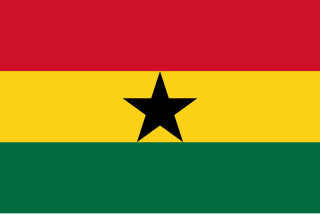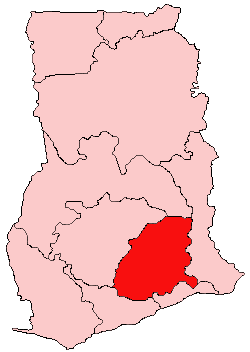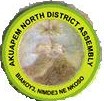
Ghana is a country of 28.21 million people and many native groups, such as:

The Ashanti Region is located in the southern part of Ghana and is the third largest of 16 administrative regions, occupying a total land surface of 24,389 km2 (9,417 sq mi) and making up 10.2 percent of the total land area of Ghana. It is the most populated region in Ghana, with a population of 5,440,463 according to the 2021 census, accounting for around one-fifth of Ghana's total population. The Ashanti Region is known for its gold bar and cocoa production. The largest city and capital of Ashanti is Kumasi.

Kwahu is an area and group of people that live in Ghana and are part of the Twi-speaking Akan group. The region has been dubbed Asaase Aban, or the Natural Fortress, given its position as the highest habitable elevation in the country. Kwahu lies in the Eastern Region of Ghana, on the west shore of Lake Volta. The Kwahus share the Eastern Region with the Akyem and Akuapem, as well as the Adangbe-Krobos. Among Kwahu lands, a significant migrant population works as traders, farm-hands, fisherfolk, and caretakers in the fertile waterfront 'melting pot' of Afram plains. These migrants are mostly from the Northern and Volta Regions, as well as, some indigenous Guans from the bordering Oti and Brong-Ahafo regions live in the Afram Plains area. Kwahus are traditionally known to be wealthy traders, owning a significant number of businesses and industries in Ghana.
Duppy is a word of African origin commonly used in various Caribbean Islands, including The Bahamas, Barbados and Jamaica, meaning ghost or spirit. The word is sometimes spelled duffy.
Articles related to Ghana include:

The Asante Empire, today commonly called the Ashanti Empire, was an Akan state that lasted from 1701 to 1901, in what is now modern-day Ghana. It expanded from the Ashanti Region to include most of Ghana and also parts of Ivory Coast and Togo. Due to the empire's military prowess, wealth, architecture, sophisticated hierarchy and culture, the Ashanti Empire has been extensively studied and has more historic records written by European, primarily British, authors than any other indigenous culture of sub-Saharan Africa.

Akropong is a town in South Ghana and is the capital of the Akuapim North District, a district in the Eastern Region of South Ghana. This town is known for producing snails and palm oil. Akropong has a 2013 settlement population of 13,785 people.
The Akan people appear to have used a traditional system of timekeeping based on a six-day week. The Gregorian seven-day week is known as nnawɔtwe (eight-days). The combination of these two system resulted in periods of 40 days, known as adaduanan.

The Asante, also known as Ashanti, are part of the Akan ethnic group and are native to the Ashanti Region of modern-day Ghana. Asantes are the last group to emerge out of the various Akan civilisations. Twi is spoken by over nine million Asante people as a first or second language.

Akan religion comprises the traditional beliefs and religious practices of the Akan people of Ghana and eastern Ivory Coast. Akan religion is referred to as Akom. Although most Akan people have identified as Christians since the early 20th century, Akan religion remains practiced by some and is often syncretized with Christianity. The Akan have many subgroups, so the religion varies greatly by region and subgroup. Similar to other traditional religions of West and Central Africa such as West African Vodun, Yoruba religion, or Odinani, Akan cosmology consists of a senior god who generally does not interact with humans and many gods who assist humans.

The Akwasidae Festival is celebrated by the Ashanti people and chiefs in Ashanti, as well as the Ashanti diaspora. The festival is celebrated on a Sunday, once every six weeks.
The Odwira festival is celebrated by the chiefs and peoples of Fanteakwa District and Akuapem in the Eastern Region of Ghana. The Odwira Festival is celebrated by the people of Akropong-Akuapim, Aburi, Larteh, and Mamfe. This is celebrated annually in the month of September and October. The festival celebrates a historic victory over the Ashanti in 1826. This was the battle of Katamansu near Dodowa. It was first celebrated in October 1826.
Akua is an Akan female given name among the Akan people in Ghana that means "born on a Wednesday" in Akan language, following their day naming system. People born on particular days are supposed to exhibit the characteristics or attributes and philosophy, associated with the days.
Adae Kese Festival is an important albeit rare celebration among the Ashantis in Ghana. There are two main periods for this celebration: one is Awukudae, and the other is Akwasidae. It glorifies the achievements of the Asante kingdom. It was first celebrated to the achievement of statehood of the people, after the war that the Ashantis had their independence, in the Battle of Feyiase which they fought against the people of Denkyira. It is also the occasion when the purification ceremony of Odwira is performed at the burial shrines of ancestral spirits. Generally, this coincides with the harvest season of yam and hence the ritual was also called the "Yam custom" by Europeans. It is celebrated every two weeks by the people in accordance with the calendar of the Akans based on the cycle of forty-two days and nine months in their calendar. The festival is mostly held to climax celebrations of specific achievements and milestones of the people of the Ashanti kingdom. The festival is a day of rest so it is forbidden to work on that day.

Adae Festival is a celebration in Ashanti. Considered a day of rest, it is the most important ancestral custom of the Ashanti people.

The Ashanti Yam Festival is an annual celebration of the Ashanti people of Ashanti. It marks the first harvest of yams during the autumn season, after the monsoon season. The yam is the staple food crop in Ashanti and most of Africa.

An Akrafena is an Ashanti sword, originally meant for warfare but also forming part of Ashanti heraldry. The foremost example of an akrafena is the Mponponsuo, which belonged to Opoku Ware II. It has survived to the present day because it is still occasionally used in ceremonies, such as the Akwasidae Festival.
Berekuso is a town in the Eastern Region of Ghana, approximately an hour from Accra. It is located in the foothills of the Aburi Ridge, on a road linking the Accra suburb of Kwabenya with the hills around Aburi. The town is known for being the location of Ashesi University, the first liberal arts college in sub-Saharan Africa.

The Ashanti Empire was governed by an elected monarch with its political power centralised. The entire government was a federation. By the 19th century, the Empire had a total population of 3 million. The Ashanti society was matrilineal as most families were extended and were headed by a male elder who was assisted by a female elder. Asante twi was the most common and official language. At its peak from the 18th–19th centuries, the Empire extended from the Komoé River in the West to the Togo Mountains in the East.











